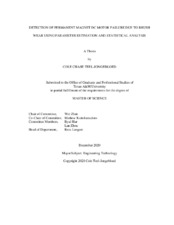| dc.description.abstract | Failure detection of DC motors is a common study, and could be extremely useful in real world applications. Undiagnosed eminent motor failure could cause a range of effects, and without maintenance will inevitably occur. Motor faults can be classified as electrical or mechanical, both with wide ranges of causes. Electrical failure includes stator or rotor winding faults, inverter faults, position of sensor faults in brushless motors, bearing faults, and brush faults. Mechanical faults include bearing faults, broken rotor bar, rotor eccentricity faults, end ring faults, and load faults. The aim of this study was to observe the effect of brush fault within a permanent magnet DC (PMDC) motor. Carbon contact brushes are used in PMDC motors to transmit electrical current from the stator of the motor to the rotor of the motor, ensuring the rotation of the commutators. Over time, the carbon contact becomes worn down from commutators continually moving across them. As the contacts length is decreased, the spring holding it in place becomes more stretched out, putting in more effort to hold the brush in place. This introduces a resistance, referred to as a contact resistance, that can affect the motor speed and performance. Changes in speed and resistance can be measured and observed, and curves can be fitted to their relationship with statistical significance. We can also create a simulation method using basic differential equations that describe the motor and introducing random noise to the simulation with generation of random numbers for the motor parameters. Finally, a confidence interval is generated, and eminent motor failure can be predicted when values measured values stray from the simulated path. Erratic motor behavior can also be observed at the point of eminent motor failure. | en |


